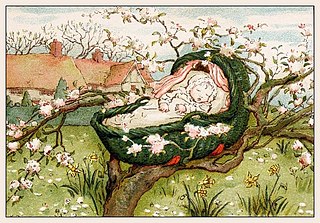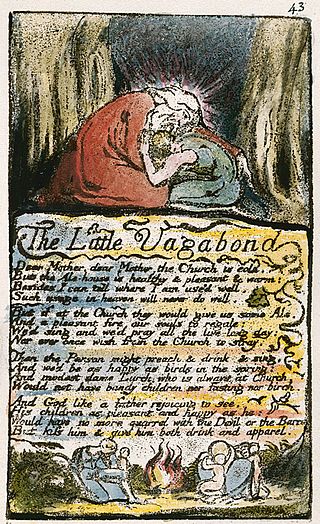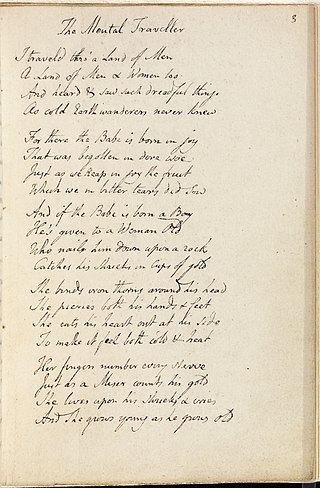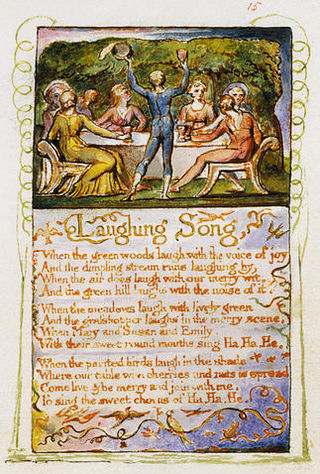
"A Cradle Song" is a poem written by William Blake in 1789, as part of his book Songs of Innocence .

"A Cradle Song" is a poem written by William Blake in 1789, as part of his book Songs of Innocence .
The 32-line poem is divided into 8 stanzas of 4 lines each. Each stanza follows an "AABB" rhyme scheme.
“A Cradle Song” follows a couplet structure where each pair of lines rhyme. This lends the poem a graceful sound and makes it easy to sing. While writing this poem, Blake drew from the image of a mother sitting over her infant while the baby is in her crib falling sleep.
Blake was born in London on November 28, 1757. He died on August 12, 1827. [1] He claimed that in a dream his brother Robert taught him the printing method that he used in Songs of Innocence and other illuminated works. [1] Songs of Innocence includes poems about children and the clash between the corruption of the world and the innocence of youth. He uses imagery throughout Songs of Innocence.
In “A Cradle Song”, a mother sings to her child, asking the infant to stay asleep. The mother asks her child to sleep through the night. While she looks at her infant's face, the mother sees Jesus. When she sees the infant smiling, she sees Jesus smiling at her and the world. At the end of the poem, she states how heaven and earth are at peace and have harmony when she sees her baby smile.
A key theme in “A Cradle Song” is the mother's love for her child. The mother uses the word “sweet” ten times in the poem. She makes the infant seem angelic by the way she describes the child. The mother claims her child is “dovelike”, using the dove as a symbol for holiness and love. The woman ties the spiritual world to the physical. She notes how she can trace His (Christ's) holy image on her baby. The mother tells the baby to sleep as she cries, representing how the mother is aware of the sinful world her baby will grow up and eventually die in. She claims how Jesus wept for all and wept for her. The mother has faith that her infant will be okay even when she can no longer protect her, but it still saddens her to not be able to shield her from the world.
There are famous artists that have claimed that they were inspired by William Blake, including Bob Dylan, John Lennon, and The Beatles, Bono and U2, Led Zeppelin, and many more. [2] Some have even used Blake's poems in the creation of their music. In A Charm of Lullabies, Benjamin Britten sets "A Cradle Song" to music alongside four other poems. [3]

A lullaby, or a cradle song, is a soothing song or piece of music that is usually played for children. The purposes of lullabies vary. In some societies they are used to pass down cultural knowledge or tradition. In addition, lullabies are often used for the developing of communication skills, indication of emotional intent, maintenance of infants' undivided attention, modulation of infants' arousal, and regulation of behavior. Perhaps one of the most important uses of lullabies is as a sleep aid for infants. As a result, the music is often simple and repetitive. Lullabies can be found in many countries, and have existed since ancient times.

"The Tyger" is a poem by the English poet William Blake, published in 1794 as part of his Songs of Experience collection and rising to prominence in the romantic period. The poem is one of the most anthologised in the English literary canon, and has been the subject of both literary criticism and many adaptations, including various musical versions. The poem explores and questions Christian religious paradigms prevalent in late 18th century and early 19th century England, discussing God's intention and motivation for creating both the tiger and the Lamb.

"The Lamb" is a poem by William Blake, published in Songs of Innocence in 1789.

"The Chimney Sweeper" is the title of a poem by William Blake, published in two parts in Songs of Innocence in 1789 and Songs of Experience in 1794. The poem "The Chimney Sweeper" is set against the dark background of child labour that was prominent in England in the late 18th and 19th centuries. At the age of four and five, boys were sold to clean chimneys, due to their small size. These children were oppressed and had a diminutive existence that was socially accepted at the time. Children in this field of work were often unfed and poorly clothed. In most cases, these children died from either falling through the chimneys or from lung damage and other horrible diseases from breathing in the soot. In the earlier poem, a young chimney sweeper recounts a dream by one of his fellows, in which an angel rescues the boys from coffins and takes them to a sunny meadow; in the later poem, an apparently adult speaker encounters a child chimney sweeper abandoned in the snow while his parents are at church or possibly even suffered death where church is referring to being with God.

Songs of Innocence and of Experience is a collection of illustrated poems by William Blake. Originally, Blake illuminated and bound Songs of Innocence and Songs of Experience separately. It was only in 1795 that Blake combined the two sets of poems into a volume titled Songs of Innocence and of Experience Shewing the Two Contrary States of the Human Soul. Even after beginning to print the poems together, Blake continued to produce individual volumes for each of the two sets of poetry.

"Rock-a-bye baby on the tree top" is a nursery rhyme and lullaby. It has a Roud Folk Song Index number of 2768.

"London" is a poem by William Blake, published in Songs of Experience in 1794. It is one of the few poems in Songs of Experience that does not have a corresponding poem in Songs of Innocence. Blake lived in London so writes of it as a resident rather than a visitor. The poems reference the "Two Contrary States of the Human Soul". The "Songs of Innocence" section contains poems which reference love, childhood and nature. Critics have suggested that the poems illustrate the effects of modernity on people and nature, through the discussion of dangerous industrial conditions, child labour, prostitution and poverty.

"The Blossom" is a poem by William Blake, published in Songs of Innocence in 1789.

"Holy Thursday" is a poem by William Blake, first published in Songs of Innocence and Experience in 1794. This poem, unlike its companion poem in "Songs of Innocence" (1789), focuses more on society as a whole than on the ceremony held in London.

The Little Girl Lost is a 1794 poem published by William Blake in his collection Songs of Innocence and of Experience. According to scholar, Grevel Lindop, this poem represents Blake's pattern of the transition between "the spontaneous, imaginative Innocence of childhood" to the "complex and mature adult state of Experience."

The Little Vagabond is a 1794 poem by English poet William Blake in his collection Songs of Innocence and of Experience. His collection, Songs of Innocence, was originally published alone, in 1789. The scholar Robert Gleckner says that the poem is a form of transformation of the boy in the poem "The School Boy", from Songs of Innocence.

"Infant Joy" is a poem written by the English poet William Blake. It was first published as part of his collection Songs of Innocence in 1789 and is the counterpart to "Infant Sorrow", which was published at a later date in Songs of Experience in 1794.

The Mental Traveller is a poem by William Blake. It is part of a collection of unpublished works called The Pickering Manuscript and was written in a manner that suggests the poem was to be read directly from the collection.
"Night" is a poem in the illuminated 1789 collection Songs of Innocence by William Blake, later incorporated into the larger compilation Songs of Innocence and of Experience. "Night" speaks about the coming of evil when darkness arrives, as angels protect and keep the sheep from the impending dangers.

Spring is a lyric poem written and illustrated by William Blake. It was first published in Songs of Innocence (1789) and later in Songs of Innocence and Experience (1794).

"The Little Boy Found" is a poem by William Blake first published in the collection Songs of Innocence in 1789. Songs of Innocence was printed using illuminated printing, a style Blake created. By integrating the images with the poems the reader was better able to understand the meaning behind each of Blake's poems.

"The Little Boy Lost" is a simple lyric poem written by William Blake. This poem is part of a larger work titled Songs of Innocence which was published in the year 1789. "The Little Boy Lost" is a prelude to "The Little Boy Found".

"Laughing Song" is a poem published in 1789 by the English poet William Blake. This poem is one of nineteen in Blake's collection Songs of Innocence.
A Charm of Lullabies, Op.41 is a song cycle for mezzo-soprano with piano accompaniment by Benjamin Britten. It consists of five songs composed on poems by William Blake, Robert Burns, Robert Greene, Thomas Randolph and John Phillip. It was written in 1947 for Nancy Evans, who gave the first performance with Felix de Nobel (piano) at a festival in The Hague 3 January 1948. The score was first published in 1949 by Boosey and Hawkes in London.

"The School Boy" is a 1789 poem by William Blake and published as a part of his poetry collection entitled Songs of Experience. These poems were later added with Blake's Songs of Innocence to create the entire collection entitled "Songs of Innocence and of Experience Shewing the Two Contrary States of the Human Soul". This collection included poems such as "The Tyger", "The Little Boy Lost", "Infant Joy" and "The Shepherd". These poems are illustrated with colorful artwork created by Blake first in 1789. The first printing in 1789 consisted of sixteen copies. None of the copies of Songs of Innocence are exactly alike as some of them are incomplete or were colored in posthumously "in imitation of" other copies.